| Article ID | Journal | Published Year | Pages | File Type |
|---|---|---|---|---|
| 4342233 | Neuroscience | 2006 | 11 Pages |
Food intake is regulated by signals from the gastrointestinal tract. Both stimulation and inhibition of food intake may be mediated by upper gastrointestinal tract hormones, e.g. ghrelin and cholecystokinin that act at least partly via vagal afferent neurones. We now report that vagal afferent neurones in both rat and man express melanin-concentrating hormone and its receptor, melanin-concentrating hormone-1R. In nodose ganglia from rats fasted for 24 h, RT-PCR revealed the expression of both melanin-concentrating hormone and melanin-concentrating hormone-1R, whereas in ganglia from animals fed ad libitum expression was virtually undetectable. Immunohistochemical studies also revealed expression of melanin-concentrating hormone and melanin-concentrating hormone-1R in nodose ganglion neurones of fasted rats, but signals were weak in rats fed ad libitum. Melanin-concentrating hormone and melanin-concentrating hormone-1R were expressed in the same neurones, a high proportion of which also expressed the cholecystokinin-1 receptor. When fasted rats were refed, there was down-regulation of melanin-concentrating hormone and melanin-concentrating hormone-1R expression over a period of 5 h. Similar effects were produced by administration of cholecystokinin to fasted rats. The cholecystokinin-1 receptor antagonist lorglumide inhibited food-induced down-regulation of melanin-concentrating hormone and melanin-concentrating hormone-1R. We conclude that the satiety hormone cholecystokinin acts on vagal afferent neurones to inhibit expression of melanin-concentrating hormone and its receptor. Since the melanin-concentrating hormone system is associated with stimulation of food intake this effect of cholecystokinin may contribute to its action as a satiety hormone.
